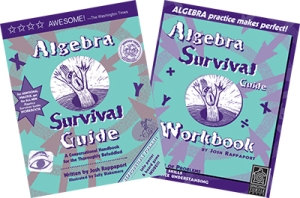How to Combine Positive & Negative Numbers — Quickly and Easily
If you or someone you know struggles when combining numbers with opposite signs — one positive, the other negative — this post is for you!
To be clear, I’m referring to problems like these:
– 2 + 7 [first number negative, second number positive], or
+ 13 – 20 [first number positive, second number negative]
To work out the answers, turn each problem into a math-story. In this case, turn it into the story of a tug-of-war battle. Here’s how.
In the first problem, – 2 + 7, view the – 2 as meaning there are 2 people on the “negative” team; similarly, view the + 7 as meaning there are 7 people on the “positive” team.
There are just three things to keep in mind for this math-story:
1) Every “person” participating in the tug-of-war is equally strong.
2) The team with more people always wins; the team with fewer people always loses.
3) In the story we figure out by how many people the winning team “outnumbers” the other team. That’s simple; it just means how many more people are on that team than are on the other team. Example: if the negative team has 2 people and the positive team has 7 people, we say the positive team “outnumbers” the negative team by 5 people, since 7 is 5 more than 2.
Now to simplify such a problem, just answer three simple questions:
1) How many people are on each team?
In our first problem, – 2 + 7, there are 2 people on the negative team and 7 people on the positive team.
2) Which team WINS?
Since there are more people on the positive team, the positive team wins.
3) By how many people does the winning team OUTNUMBER the losing team?
Since the positives have 7 while the negatives have only 2, the positives outnumber the negatives by 5.
Now ignore the answer to the intro question, Question 1, but put together your answers to Questions 2 and 3.
ANSWER TO QUESTION 2: +
ANSWER TO QUESTION 3: 5
ANSWERS TOGETHER: + 5
All in all, this tells us that: – 2 + 7 = + 5
For those of you who’ve torn your hair out over such problems, I have good news …
… THEY REALLY ARE THIS SIMPLE!
But to believe this, it will help to work out one more problem: + 13 – 20.
Here, again, are the common-sense questions, along with their answers.
1) How many people are on each team?
In this problem, + 13 – 20, there are 13 people on the positive team and 20 people on the negative team.
2) Which team WINS?
Since there are more people on the negative team in this problem, the negative team wins.
3) By how many people does the winning team OUTNUMBER the losing team?
Since the negatives have 20 while the positives have only 13, the negatives outnumber the positives by 7.
Just as you did in the first problem, put together your answers to Questions 2 and 3.
ANSWER TO QUESTION 2: –
ANSWER TO QUESTION 3: 7
ANSWERS TOGETHER: – 7
All in all, this tells us that: + 13 – 20 = – 7
Now try these for practice:
a) – 3 + 9
b) + 1 – 4
c) – 9 + 23
d) – 37 + 19
e) + 49 – 82
Answer to Practice Problems:
a) – 3 + 9 = + 6
b) + 1 – 4 = – 3
c) – 9 + 23 = + 14
d) – 37 + 19 = – 18
e) + 49 – 82 = – 33
Josh Rappaport is the author of five books on math, including the Parents Choice-award winning Algebra Survival Guide. If you like the way Josh explains these problems, you will very likely like the Algebra Survival Guide and companion Workbook, both of which are available on Amazon.com Just click the links in the sidebar for more information!


















 Math Tutors, Santa Fe, NM
Math Tutors, Santa Fe, NM